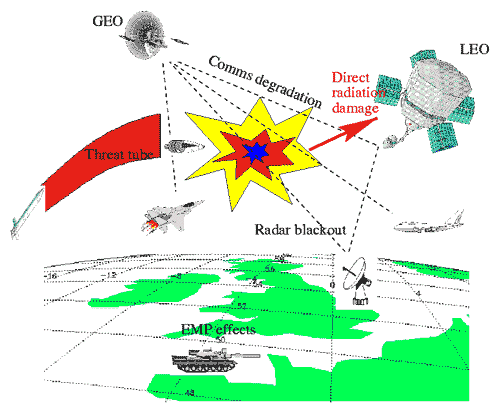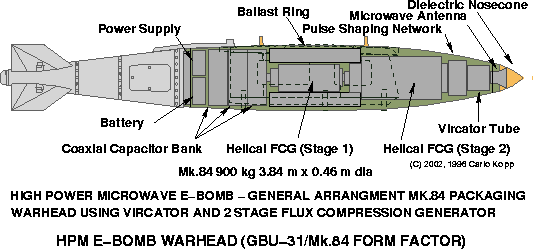 |
| "Are
you still there?" was the first radio transmission
received at Johnston Island hours after the TEAK thermonuclear
test on August 1, 1958. The 3.8 megaton, 77-kilometer-high
blast triggered an electromagnetic pulse (EMP) which
stopped radio communications throughout that large
area of the Pacific. The EMP was so severe that military
and civilian aircraft had to be grounded in Hawaii.
The TEAK fireball could be seen as far away as Oahu
Island, approximately 525 nautical miles from Johnston
Island. Eyewitnesses said the colorful display rivaled
the "Southern Lights," also referred to
as the Aurora Australis. Several scientists viewing
the test had to duck into a shelter quickly because
an error with the launch vehicle, a Redstone rocket,
caused it to detonate directly over Johnston Island
instead of 20 miles down range. |
The US armed forces infrastructure, and
American society at large, remain vulnerable to a debilitating
attack by an electromagnetic pulse (EMP) generated by
a high-altitude nuclear blast, a senior-level, congressionally
appointed panel has warned.
Several potential adversaries, such as
China, are capable of launching a crippling EMP strike
against the US with a nuclear-tipped ballistic missile,
and others, such as North Korea or even terrorist groups,
could have the capability by 2015, the panel said in its
findings that it unveiled to US legislators at a hearing
on 22 July.
Panel members said this type of attack
may be an appealing option, especially for an unsophisticated
opponent. One possible scenario is a 'Scud' missile, with
a modified nuclear warhead to maximise the EMP effect,
launched from a barge off the US coast.
While the US military has grown increasingly
dependent on computers, electronics and information systems,
it has relaxed requirements for EMP-hardened systems since
the end of the Cold War and its overall record of adherence
to its guidelines for such robust equipment "has
been spotty", they said. This trend continues "in
the wrong direction", the panel noted.
Similarly, the US civilian critical infrastructure
is not adequately prepared to deal with the effects of
an EMP attack, according to the panel, which is known
formally as the Commission to Assess the Threat to the
United States from Electromagnetic Pulse Attack. Congress
created the panel in 2000 out of concern that this issue
was not receiving enough attention.
An EMP attack, for example, could place
the nation's electrical grid "in danger of fundamental
collapse", said commission chairman William Graham,
who served as scientific advisor to US President Ronald
Reagan in the 1980s. The overall effects could be long
lasting and difficult to recover from, he added. An EMP
strike would also be likely to knock out non-hardened
satellites in low-Earth orbit "within days or weeks",
he said, noting that commercial satellites are especially
vulnerable. Interest in a big penetrating bomb is growing
in some US defence circles, including the Defense Science
Board (DSB), the senior policy advisory panel to the Secretary
of Defense. It recommended in its February 2004 report
on 'Future Strategic Strike Forces' that the Department
of Defense "immediately undertake" a demonstration
of a "bomber-delivered massive penetrator" weapon
as part of a family of ultra-large bombs that would "improve
conventional attack effectiveness against deep, expansive,
underground tunnel facilities."

U.S.
High Power Microwave Electromagnetic Bomb Pictured Below:

|